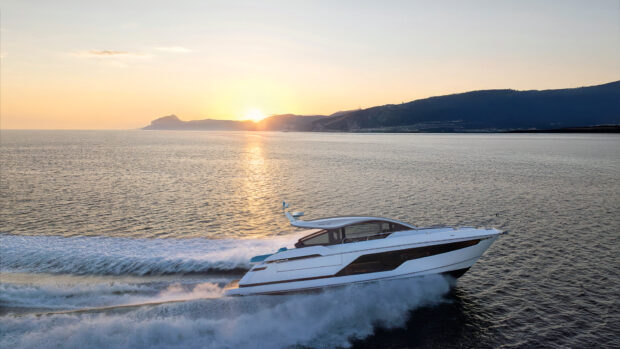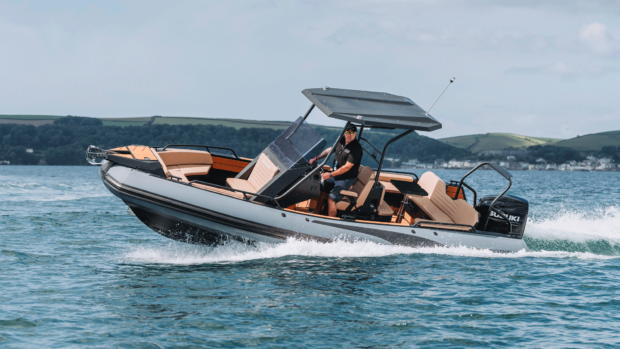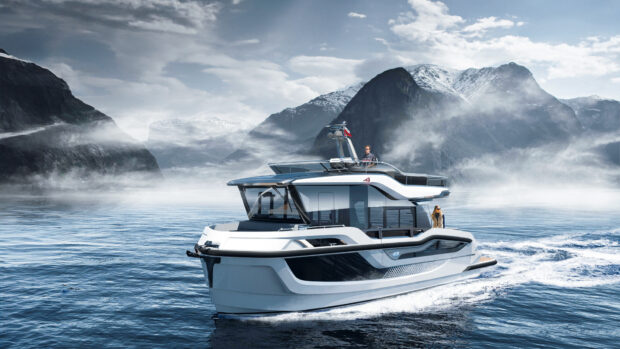Scott (TK) and Mary escape the winds in the protected bay of Caleta Cove and reflect on the eventful last few days
Position: Caleta Cove , Chile
Scott and Mary Flanders left Gibraltar on 16 September 2006, and we’ll be following their journey every step of the way, thanks to this unique online “blog”. For a complete list of all the couple’s blog entries click here
Scott (YT) and Mary escape the winds in the protected bay of Caleta Cove and reflect on the eventful last few days
Friday 7 December
Well, mis amigos, rain, rain, rain mixed with snow and so on. Today was a ‘liveaboard’ day here in Caleta Olla watching the continuous waves blow through. YT finished reading ‘Two Years Before The Mast’ by Richard Henry Dana Jr before getting suited up in plastic clothes to check the crab trap. This time it was baited with a juicy can of sardines with holes poked in both sides. Nada. Zip. So we moved it for another go.
Cruising in today’s climate is quite different compared to in Dana’s era (1834-35). One remnant of the past, however, at least for the last few days, is the daily allowance of hard bread. When leaving Ushuaia we bought ten loaves of just baked French bread wrapped to go. While sitting in Puerto Williams one evening we heard the water pump go on (as every boater knows it doesn’t take long to identify with every sound aboard, familiar and unfamiliar). The water pump didn’t shut off so Mary raced to the circuit breaker panel and switched off the pump while YT grabbed a flashlight to investigate. First, up came the master berth under which most of the water connections are – nothing, dry. Next we checked under the master head sink, the galley sink and then the forward head. Bingo. We had filled the guest shower with consumables, two-litre bottles of soda water and coke, paper towels, heavy veggies and our precious French bread. A few heavy loaves of French bread (weighing 1 kilo each) had fallen over and turned on our shower handle and now everything was nicely sprinkled. We re-wrapped the bread, all but one loaf that got soaked. That loaf we left out to dry and it is now our daily allowance of very hard bread. Perfect for toast.
Saturday 8 December
The barometer is rocketing down (978 so far) but it is clear, with some sun and windy. In addition to our analogue barometer we have a digital recording barometer, which gives us current readings, 1 hour, 3 hours, 6 hours, 12 hours and 24 hours. Graphic.
Today we took a long hike up above glacier Holandia and its inland lake below. A number of times along the way we stopped and sat down. It is difficult to describe how pretty it is. We did notice that the glacier and its basin is an illustrative example of glaciers advancing, then retreating. At the terminal end of the lake is the pushed up dirt moraine, which stands 100ft above the lake. Around two edges the rocks have been worn smooth by advancing and retreating ice. Another area of vertical moraine runs along a side.
Sunday 9 December
TK is snug in his anchor roller and Egret is under way. There is little wind, a rising barometer (984) and a bit of light snow. We are travelling west on Brazo Noroeste (NW arm of the Beagle Channel) with Tierra del Fuego to starboard (N) and Isla Gordon to port. Both sides of the Beagle are littered with glaciers, nine within the next six miles and between and below the glaciers are small waterfalls. We just went past the waterfall where last January Egret slowly bumped up to shore and Jim Leishman climbed over TK to the rocks with a garden hose to fill the water tank from the waterfall. He immediately filled one sea boot with ice water but braved it out holding the funnel under the waterfall. We didn’t really need water; we did it because we could. On the protected side, Isla Gordon, the snow dusting is down well into the tree line.
Glacier Italia (the first glacier W of Caleta Olla) spits out floating chunks of ice all year round and a few pieces of ice made their way into our anchorage yesterday afternoon. We tried taking pictures of Italia this morning when we went by but it was very overcast and foggy. The entire area around Isla Gordon is considered the ‘glacier loop’ and it is the prettiest area in the Deep South. Gordon Island is roughly a 28-mile-long horizontal island with fjords entering from the north and south to the interior. We’ll be past this area by early afternoon looking for our next anchorage so we can sit out the high winds that are coming for the next couple of days. We have several choices of where to anchor; depending on how much distance we can cover against the tide. We are currently going 5.7 knots, which is not bad considering we are travelling west.
Winds in this region are filtered by the mountains, which make directional and true wind speed forecasting inaccurate at best. Ushuaia was more predictable because of the funnelling effect of the mountains – it’s nearly always windier than predicted. As some fronts (westerly lows) meet the Andes they tend to turn south then wrap around Cape Horn. Other lows tend to trek down the middle of the Drake Passage as the summer season progresses. As we travel further west we come in more direct contact with the SW, W and NW winds. Here the winds slam into the southern Chilean coast with full force so obviously it is important to tuck in well at each anchorage, particularly over this next 150-mile stretch to the west and north.
For the two difficult southern passage areas, Straits of Magellan and Golfo de Penas, we will use a professional weather forecaster as a secondary source of weather. These two areas are not areas where you can afford to make a mistake so it is prudent to get all the help you can. For the rest of the trip to Puerto Montt we are more protected so we’ll just use the grib files (OMNI Bob, Bob Jones, Ocean Marine Navigation, Inc ocmarnav@aol.com 866 505-6664) which helped Egret on her Atlantic crossing last year and more recently forecasted for the Med Bound 2007 group’s Atlantic crossing. Again like last year we will post OMNI Bob’s weather forecasts with each update.
We are now passing Romanche Glacier with its huge waterfall exiting from under the ice down to the Beagle. Below the highest drop is a large, house size remnant of ice that slid during winter. When Darwin was exploring this glacier in the Beagle’s longboat a large chunk of ice calved into the water creating a wave that nearly washed away the longboat leaving their small party stranded. There is lots of history here amigos.
Now it’s an obvious avalanche scar going by on the starboard side (N) along with more waterfalls. As tough as this area is it is also fragile. A scar like this, denuded of trees with a grass covering may take many hundreds of years to reforest itself. In the Harberton area, trees are lying down looking intact from a fire over a hundred years ago and it still looks like it did shortly after the fire. We are certainly going to miss this wild and rugged place.
It is now snowing heavily but at least the radar is punching through and giving us a clear picture ahead. What happened to early summer? We are just glad we are in our toasty pilothouse with our buss heater pumping out hot, dry air. Not having to look through salt-caked, snow-ringed eyes is also a big plus. A fellow boater we met a few months ago could not understand how we have never turned on our windshield wipers. He began to argue until I repeated myself (what part of never didn’t he understand) and showed him how one blade is missing and the spare is in the chart storage area under the pilothouse settee.
Mary uses RainX on the pilothouse glass from time to time to shed the water. Even at night we see well through the salt on the windshield because there is no reflection. Heavy spray is self-cleaning, while light spray sticks, particularly when it’s hot. We rinse the glass with the saltwater washdown hose if there is a lot of salt and it is calm enough.
Egret is anchored in Caleta Emilita on Isla O’Brien. This is a small buttonhole anchorage on the east side of the island, which gives protection from all quarters except the east. We have two lines ashore to the trees.
There are two small waterfalls behind us. Isla O’Brien is the dividing line between the forested eastern part of Chilean Tierra del Fuego and the scrub, wind scoured western part. With the constant high winds, rain and so on nothing substantial can survive.
Today the weather has been unpredictable, we dropped the dinghy in hail, but there was little wind two miles from the anchorage in the lee of some small islands. Fog obscured the anchorage until we were close but radar and a GPS waypoint showed us the way. We anchored in calm and sunshine. Wild!! According to the Italian guide hiking is excellent here and very easy from the looks of things. If we have mucho wind tomorrow (Mon) we’ll stay and hike. If not, we’ll take advantage of the good weather and move to the next anchorage.
Monday 10 December
Here we sit in our little protected pool while the wind rips Canal O’Brien to the south of us. The protective wind shadow reaches well beyond our anchorage and tomorrow promises (I should say appears – there are no promises here) to start windy then clear during the day. After checking the weather this evening we’ll move in the early morning for the run to the next anchorage if there are no changes.










